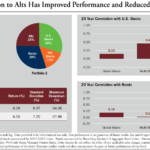Alternative Facts
For many investors, there are two main asset classes that are considered for portfolio construction: Equity and Fixed Income. Equities tend to be more volatile and provide the capital appreciation investors require to compensate for risk and to reach their investment goals. Fixed Income provides income in retirement, stability during drawdowns, and has historically been viewed as a portfolio diversifier. What if I said there was a third asset class that can decrease the risk of a portfolio and potentially increase returns? This asset class has been known as Alternatives and has been gaining in popularity for their ability to increase the risk-adjusted return of a portfolio.
Brief History of Alternatives
After the dotcom crash of the early 2000s, large institutional investors, such as endowments and pensions, began to seek alternative strategies to better protect their portfolios during turbulent times. These large institutions sought out hedge funds and other large money managers that could provide better protection during difficult times. During the 2007-2009 financial crisis, these strategies showed their worth and had significantly reduced risk. After seeing the benefits these strategies had provided, fund companies began to replicate these strategies on a larger scale for retail investors and asset managers in the form of liquid alternatives. (see image #1 below)
Next, I will review why we use liquid alternative funds at HFS, and the different strategies available.
Benefits of Liquid Alt Funds
Liquid Alt funds provide three main benefits for client portfolios:
- Higher growth and income potential compared to Fixed Income
- Though rates have been rising steadily since the bottoming out in July of 2016, these continue to remain low relative to historical standards, while spreads have tightened in some sectors to historical lows.
- Liquid Alt strategies can seek out market inefficiencies and illiquid investments that many traditional bond managers are unable to target.
- Reduced volatility compared to Equities
- In the past 20 years we have witnessed two recessions with equity prices plummeting each time over 40%.
- Liquid alt strategies can take the form of market neutral or hedged strategies, significantly reducing market risk. These strategies can also short equities giving them an option that traditional equity managers and index trackers are unable to offer.
- Core diversifier
- The inclusion of liquid alts provides an allocation to an asset class that will have a low or negative correlation to a typical equity/bond portfolio.
(see image #2 below)
Alternative Strategies
There is a longer list of liquid alt strategies available. Below I will show the strategies we implement at HFS.
- Long/Short Credit
- This sector focuses on market discrepancies within the fixed income market.
- Can also take on a more active income approach and seek out illiquid securities.
- Long/Short Equity
- This sector focuses on hedging equity risk from a client portfolio.
- Can also benefit from shorting overvalued companies and going long more attractive companies.
- Global Macro
- This sector focuses on macroeconomic events and will go long or short different asset classes, market caps, debt securities, or currencies.
- Managed Futures
- This sector focuses on going long or short varying amounts of futures contracts targeting areas as common as S&P 500 contracts to less common sectors ranging from currencies, gold, oil, and soft commodity contracts such as coffee or sugar.
- Each fund focuses on their own proprietary trading strategy and are systematic trend followers. Managed Futures strategies tend to be the least correlated but also the most volatile.
- Event Driven
- This sector focuses on the organizational changes at a company either through a merger, reorganization, or other managerial changes.
- The most common strategy is built around merger arbitrage (attempting to earn two or three times the risk-free rate, often the spread between the agreed upon takeover price minus the current trading price of the target company).
Below is a breakdown of the major benefits and the strategy associated with each benefit.
Main Benefits and Strategies Used
- Higher growth and income potential compared to Fixed Income
- Long/Short Debt
- Event Driven
- Reduced volatility compared to Equities
- Long/Short Equity
- Event Driven
- Core diversifier
- Managed Futures
- Global Macro
Though Alternatives can play a vital role in portfolios, there are challenges and due diligence is a must.
- Manager selection is more important than it would be in equity or fixed income investing. The gap between the winners or losers within a category is more noticeable.
- Continued scrutiny of the underlying holdings in the fund is important given a fund’s ability to take leverage or shift from their initial intent.
- Because of their benefits in a portfolio, it is important to keep a strategic weight and not try to time strategies. Market timing only hinders the long-term effect of using the funds in the first place.
| Written by Antonio Belmonte
|
These are the opinions of Antonio Belmonte and not necessarily those of Cambridge, are for informational purposes only, and should not be construed or acted upon as individualized investment advice. Investing involves risk. Depending on the types of investments, there may be varying degrees of risk. Investors should be prepared to bear loss, including total loss of principal. The strategies discussed herein are not designed based on the individual needs of any one specific client or investor. In other words, it is not a customized strategy designed on the specific financial circumstances of the client. However, prior to opening an account Cambridge will consult with you to determine if your financial objectives are appropriate for investing in the model. You are also provided the opportunity to place reasonable restrictions on the securities held in your account
- Image #1
- Image #2


